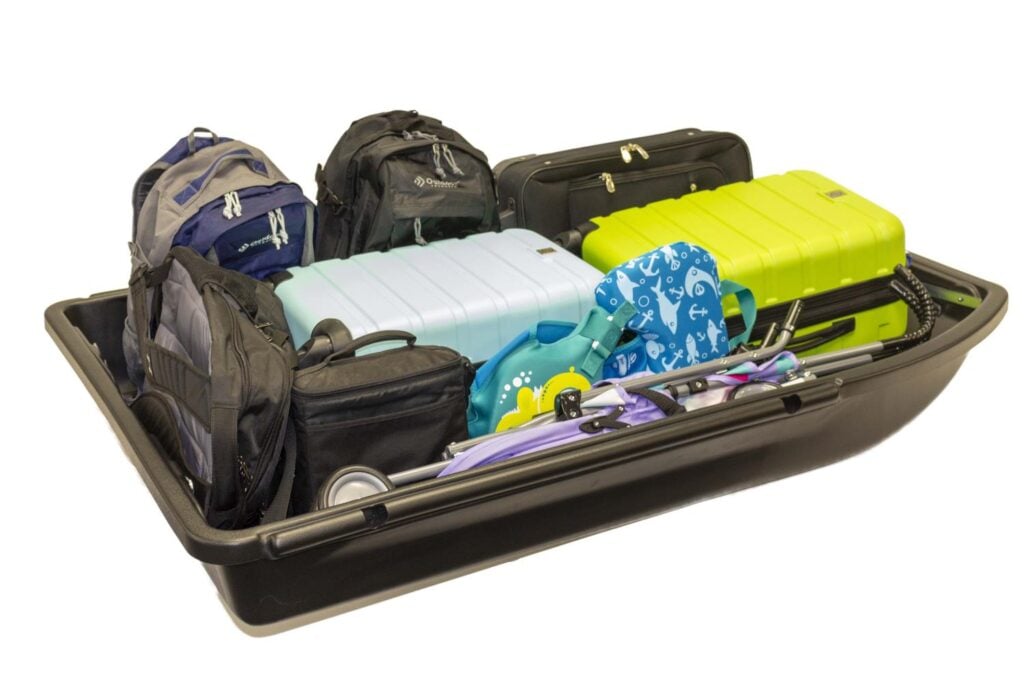Sign up now to join the JEGS email newsletter and be the first to learn about new products, special deals and e-mail only offers!


While great for increasing cargo capacity, adding a rooftop carrier to your vehicle will also affect its fuel economy.
According to data from the Environmental Protection Agency (EPA), Consumer Reports, and WhatCar, a vehicle's fuel efficiency can drop by 15-35% when equipped with a rooftop storage carrier, with the main factors being the added weight of the carrier and its impact on airflow and drag.
However, the actual mileage reduction you see also depends on the make and model of your automobile, your driving habits, the carrier type, shape, exact weight, and more.
Well, good news, this guide further details the MPG impact of adding a rooftop carrier to a car. To help you make the most of your outdoor adventures, we'll also share some simple storage tips for minimizing fuel consumption when rooftop hauling.
Let's get started.
Adding a rooftop carrier to your vehicle means adding more weight, which means your engine has to work harder, consuming more fuel in the process.
Think of it like going for a walk, where in one scenario, you're wearing a backpack, and in the other, you're not. Walking alone, you're likely to use less energy than when carrying a heavy backpack.
Similarly, your car's engine has to burn more fuel to carry the extra load of a rooftop storage carrier.
According to the U.S. Department of Energy, an extra 100 pounds can reduce a car's fuel efficiency by 2%. So, if your rooftop carrier and its contents weigh, say, 150 pounds, that could potentially decrease your fuel efficiency by around 3%.
Yet, these percentage estimates are not always linear. As the weight increases, the engine may have to work disproportionately harder, leading to a potentially higher drop in fuel efficiency. This is especially noticeable when the engine is under high stress, like when climbing a steep hill or overtaking another vehicle.
The effect of weight on fuel economy is more noticeable in smaller, lighter vehicles like sedans and compact SUVs. Larger, more powerful models, such as trucks or full-size SUVs, are built to carry more weight, so the fuel impact isn't as significant.
The position of the weight also matters. A rooftop carrier, situated on top of the vehicle, raises the center of gravity, affecting not just fuel consumption but also handling and stability. This results in the engine having to work harder to keep everything under control, especially at higher speeds or when navigating corners.
Just as weight plays a role in fuel economy, so does the way air flows around your vehicle, particularly when it comes to rooftop storage carriers.
Though great for storing extra luggage, not all carriers are made with aerodynamics in mind. They can significantly increase wind resistance (also known as drag), directly impacting your car's fuel economy.
To visualize this, think of sticking your hand out your car’s window while driving; point your fingers in the direction it’s moving, and they’ll slice through the air smoothly, but turn your palm forward, and you’ll feel resistance increase significantly.
The same principle applies to your car with a rooftop carrier. The engine works harder to counter the extra wind resistance, reducing gas mileage.
The U.S. Department of Energy (DOE) reports that the impact of rooftop hauling on fuel economy varies with speed. Fuel efficiency reductions range from 2%–8% in city driving, 6%–17% on the highway, and 10%–25% at speeds of 65–75 mph.
However, it's not just the carrier's design or your vehicle's speed that matter; wind and temperature also come into play. Per data from Freightliner, headwinds and crosswinds intensify aerodynamic drag, leading to a fuel efficiency decrease of up to 13% for every 10 mph of wind.
What's more, as the outside temperature falls, the air becomes denser, which also affects drag. For every 10-degree drop in temperature (Fahrenheit), aerodynamic drag increases by 2%, which comes to roughly a 1% reduction in mileage.

Sign up now to join the JEGS email newsletter and be the first to learn about new products, special deals and e-mail only offers!

Yes, adding a rooftop storage carrier to your vehicle will reduce its fuel efficiency. Thankfully, there are a few things you can do to help mitigate the MPG losses:
If you're not using your rooftop storage carrier, it's best to remove it. Even when empty, a rooftop carrier still adds weight to your vehicle and increases wind resistance. These factors can hinder your car's fuel economy even during day-to-day city driving or short trips. To lessen the chances of an accident, be sure to ask a friend or family member for help when loading/unloading.
Your driving style can also influence your vehicle's fuel efficiency. Rapid acceleration, high-speed driving, and frequent braking can all lead to higher fuel consumption, especially when there’s extra weight on your roof. Instead, opt for a smooth, conservative driving style. Keep your speed steady, avoid abrupt stops and starts, and keep your RPMs low to help reduce fuel consumption.
While it might be tempting to drive with the windows or sunroof open, especially on a nice day, doing so can increase wind resistance and, by default, your MPG. If it's hot out, consider using your vehicle's ventilation system instead to maintain a comfortable cabin temperature. Just note that AC usage also affects mileage, so be conservative.
A loose or poorly secured carrier can create excess drag and potentially cause safety concerns. Before heading out on your next road adventure, double-check that your rooftop carrier is securely mounted and fastened to your vehicle. Tightening all bolts, straps, and locks will reduce the carrier's movement and minimize wind resistance.
Consider the weight distribution when packing your carrier. It's generally better to place heavier items at the bottom and towards the front of the carrier, closer to the vehicle's center of gravity. Additionally, packing items tightly or securing them inside can prevent them from sliding around and shifting weight distribution.
Lastly, note that different carriers offer varying degrees of aerodynamics, weight, and storage. If you only need to carry small, light items, consider a more compact, streamlined carrier or even one that’s rear-mounted. Choosing a carrier that matches your specific needs can help you maximize your MPG and get the most out of your rooftop hauling experience.
Wrapping up, adding a rooftop storage carrier to your vehicle will impact its fuel economy by around 15-35%, depending on factors like added weight, increased wind resistance, your driving habits, and more.
Thankfully, by applying the fuel efficiency storage tips mentioned above, like removing the carrier when not in use, driving conservatively, and choosing one that suits your needs, you can help mitigate the loss.
For all your rooftop storage needs, consider JEGS. Explore our collection of rooftop storage carriers today and have your order sent straight to your door.




